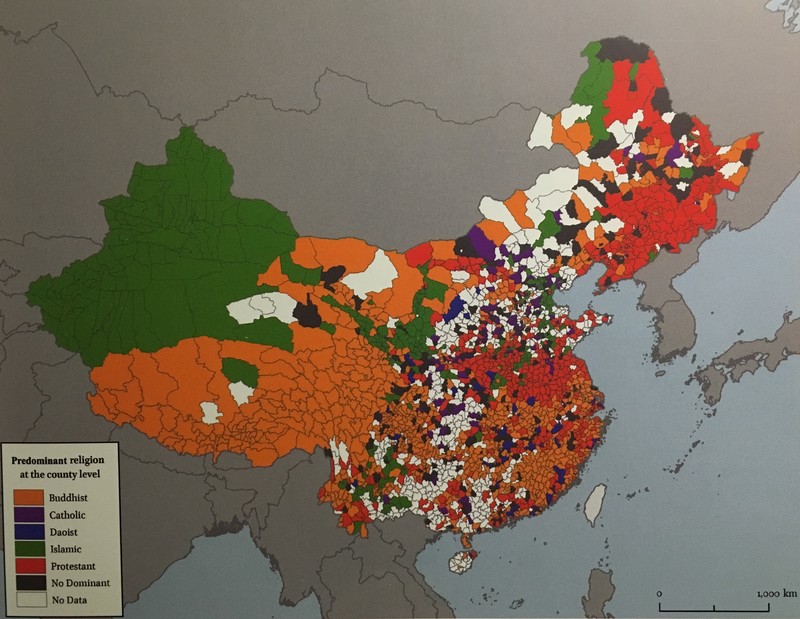Christianity has been the fastest growing religion during the Great Awakening in China. Beginning in 2000, I have interviewed several hundred Christians, including entrepreneurs and businesspeople, academic scholars in various disciplines, young professionals, lawyers who have defended people for their civil and human rights, journalists, writers, and artists. Our center at Purdue has organized several projects to document these different segments of the growing Christian population in China.
How is it possible to have such religious revivals under Communist repression? My book Religion in China offers a sociological explanation. Without getting into academic jargon, I would simply say that we may compare religion to a market. There are legally approved religious sites, organizations, and activities of the five major religions of Buddhism, Daoism, Islam, Catholicism, and Protestant Christianity. These religious organizations are in the red market. They are legally allowed and tolerated but are also colored red, the Chinese Communist color, and have to follow the party-state instructions.
The number of officially approved churches has increased. Because these officially approved churches are not allowed to spread their religion outside the church, many churches have tried to make the church more visible through erecting a big cross on top of the church, and often with a bright neon light in the night. After seeing many rooftop crosses, the Communist Party boss of Zhejiang Province became very upset, rhetorically asking his subordinates: Is this still the land under Communist authority, or has it become the land under the cross? He then ordered that all the churches must take down their rooftop crosses, or their churches would be demolished. From 2014 to 2016, more than 1,500 crosses were taken down from churches in Zhejiang Province. But this political campaign failed to remove all the crosses. More importantly, even if the cross was removed, the church could still hold worship services, although it would be under close surveillance. Many of these churches continue to baptize people into the church. This is in the red market of religion.
There is also a black market of religion. Some new religious movements or sects have been banned. The party-state has carried out severe crackdowns on them, but some of them have managed to survive and even expand. They cannot be wiped out.
Besides the red and the black, there is also a grey market of religion, where the activities are neither legal nor illegal, or marginal between legal and illegal. For example, according to the party-state regulations, preaching outside religious venues and teaching religion to children under 18 years old are not allowed, but what if people do it in their own homes with their own children? Or some relatives and friends join them as well? These home gatherings have been called house churches. In Chinese, they are called jiating churches. It is hard to say whether the jiating church is legal or illegal. It is in the grey area. The jiating church has been very effective in evangelism. Indeed, the Buddhists have also adopted this form of doing religion.
In the first decade of the twenty-first century, many jiating churches grew too big to meet at people’s apartments. Therefore, they rented large halls at hotels or office buildings. Some congregations even purchased commercial real estate and renovated them into sanctuaries. They continued to be called jiating churches because they refused to join the official Christian association that is in the religious red market. Some of the jiating churches began to form new denominations.
In the last four or five years, the party-state has imposed stricter restrictions, shut down hundreds of jiating churches, and jailed some prominent pastors and lay leaders. In spite of the suppression, many jiating church Christians have continued to evangelize in the streets and public squares, distributing Bibles, tracts, or leaflets, and inviting people to church gatherings. The police stop them and sometimes detain the most active leaders, but they are often released within 24 hours or within a couple of weeks. But as soon as they are released, most of them go back to the streets and public squares again. They have been fired up so much that they are unstoppable.
In short, repressive regulations have not reduced religions, but have complicated the religious market and resulted in the tricolor religious markets. In other words, the spiritual awakening and religious revivals are not containable or controllable, even though the party-state has been trying very hard to suppress them.
After the Cultural Revolution, five religions were given official recognition. Official documents have provided the numbers of believers in each religion. It is surprising to see that atheist education and political suppression during the Cultural Revolution did not reduce the number of Catholics. The number of Muslims remained the same as well. The number of Protestants increased three times, from about one million to three million, which is extraordinary and miraculous. Actually, this is an undercount because the party-state is unwilling to admit its failure. An American historian, Daniel Bays of Calvin College, estimated that there were about five to six million Protestants around 1980.
Then, after 1989, the growth accelerated. In 1979, churches, temples, and mosques began to reopen. The number of Catholics grew to 5.3 million by 2010. The number of Protestants grew to more than 23 million by 2010. In 2018, there were nearly 40 million Protestants. Again, these are underreports by the party-state. Some independent scholars in China and outside China have reported higher estimates.1 One scholarly book said that there were about 20 million Protestants by 1990. Another scholar said there were about 50 million in the early 2000s. The Pew Research Center estimated that there were 58 million Protestants and 9 million Catholics in 2010. Some Christian research centers and mission organizations have put out much higher estimates. The extraordinarily rapid growth of Christians in China has not been well studied or widely reported. This is perhaps the biggest hidden story in the twenty-first century.
If the growth of Christians continues at a modest rate, it is likely that within one or two decades there will be more Christians in China than in the United States. Meanwhile, Chinese Christians have been warming up for overseas missions. They have already sent hundreds of missionaries to countries along the Silk Road in Central Asia, Southeast Asia, and Africa. Some missions movements are preparing to send out twenty to thirty thousand missionaries by the year 2030. The increased suppression by the Chinese party-state may have slowed this down, but only to some degree and probably only for a short while. I think the Christian growth and missions drive have become uncontainable.
In 2018, I published the book Atlas of Religion in China: Geographical and Social Contexts, which offers the most up-to-date, comprehensive overview of the changed religious landscape in China. I used government census data, social survey data, fieldwork observations, and historical studies to describe various religions in the red, black, or grey markets. It includes many color maps, award-winning photos, and beautifully made charts. You can find many of the maps online at the Online Spiritual Atlas of the Global East.
To conclude, I’d like to turn briefly to the theme set out by the Religion Program of the Chautauqua Institution: Cooperation, Competition, and Confrontation. There is a lot of room for Chinese and American collaboration in evangelistic missions and social services around the globe. The experience that the American church has gained in these areas is much needed by the Chinese church. At the same time, there is an ideological competition between the Communist model and the American model about the way of life. Finally, confrontation is also inevitable. I think the US government, NGOs, and many individuals will continue to confront the Chinese Communist party-state about their human rights violations, especially concerning religious freedom. We Americans believe that life, liberty, and the pursuit of happiness are inalienable rights endowed by the Creator. In the globalization era, if we do not fight for these rights globally, we may lose them at home as well.
Editor’s Note: This article, together with the others in the series, was originally a lecture, given at the Chautauqua Institute on June 29, 2021. The lecture has been lightly edited and reprinted with permission.
Where Are the Churches in China? And Why?

Professor Yang will present a webinar on Thursday June 16, 2022, entitled, “Where Are the Churches in China? And Why?” It will be a deep dive into the geographical distribution of churches and the historical reasons for it. Learn more and register for this free webinar.
Endnotes
- See also the ChinaSource Blog series “How Many Christians in China?”
Image credit: Zhang Kaiyv via UnSplash

YANG Fenggang
Dr. Fenggang Yang is a professor of sociology at Purdue University and the director of the Center on Religion and the Global East. His primary research interests include the sociology of religion, religious change in China, and immigrant religion in the United States. Dr. YANG has authored numerous articles and …View Full Bio
Are you enjoying a cup of good coffee or fragrant tea while reading the latest ChinaSource post? Consider donating the cost of that “cuppa” to support our content so we can continue to serve you with the latest on Christianity in China.